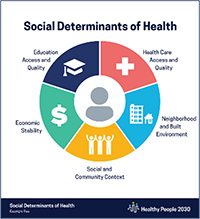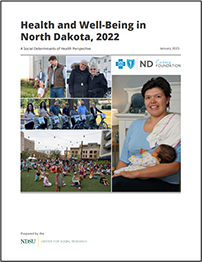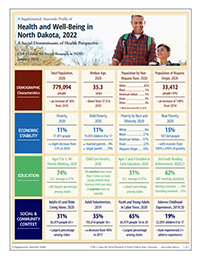Ask A Researcher
May 2023
Health and Well-Being in North Dakota
Understanding how the five social determinants of health are impacting the ability of North Dakotans to thrive.

Karen Olson is a research specialist for the Center for Social Research at NDSU. Her efforts involve a wide range of topics including migration, characteristics of the aging population, community efforts to reduce poverty, housing needs, and the health and well-being of children and families.
People’s health and well-being are essential building blocks to personal fulfillment and thriving communities. Healthy communities, in turn, affect quality of life and overall well-being. Repeated studies have found that the conditions in which we live and work have an enormous impact on our health, long before we see a doctor. The more we shift our thinking about health as something beyond what we get at the doctor’s office, but instead as something that starts in our families, in our schools and workplaces, in our playgrounds and parks, in the air we breathe, and the water we drink, the more opportunities to improve it.
These conditions where we are born, live, work, play, and age are referred to as social determinants of health – and they affect a wide range of health, functioning, and quality-of-life outcomes and risks. Understanding these factors that contribute to overall health is essential to improving health and quality of life. For example, individuals with unmet social needs including inadequate access to food or stable housing are at greater risk of developing chronic health conditions and experience more difficulty managing those conditions. Communities experiencing persistent poverty or inequality tend to disproportionately experience unmet social needs. Communities may experience structural barriers which can create disparities including exposure to toxins and environmental hazards, limited choice and access to health care services, and can lead to widespread viral transmission across communities — creating sickness and diminishing opportunities to seek appropriate care. Further, because of social risk factors or underlying health risks, some communities may also experience disproportionate impacts of natural and manmade disasters and require unique or tailored emergency response services or treatment (U.S. Centers for Medicare & Medicaid Services, 2022.
Understanding the importance of looking at health through a wider lens, leadership with the Blue Cross Blue Shield of North Dakota Caring Foundation sought to better understand the state of the social determinants of health in North Dakota and how they shape the health of North Dakotans and the communities where they live. They commissioned the Center for Social Research, an applied social science research unit at North Dakota State University, to conduct a study to better understand how economic stability, education, the social and community context, the neighborhood and built environment, and access to health care are impacting the ability of individuals living in North Dakota to thrive. This effort resulted in a final report released in January 2023, Health and Well-Being in North Dakota, 2022 – A Social Determinants of Health Perspective.
Our Approach to the Study
The social determinants of health (SDOH) categories used in the study align with those used by Healthy People 2030, an effort to set national objectives to improve health and well-being over the next decade. SDOH measures are grouped into five domains, including economic stability, education, health care, physical environment, and social and community context (U.S. Department of Health & Human Services, 2022). The report begins with an overview of the state’s demographics with respect to changing population characteristics – then moves on to describe each of the five social determinants and how they shape health outcomes in North Dakota. The individual determinants are followed by a discussion of health behaviors and finally, overall health outcomes in the state. Key metrics within each category were selected for the study based on availability by county, the ability to convey broad elements in overall health and well-being, the extent to which they provide for common interpretation, availability over time, usefulness as a tool to track long-term trends, and the validity of secondary data sources.
Overall Study Findings
North Dakota has many assets. North Dakota’s population is growing and becoming more diverse. North Dakota’s economy is generally strong overall. While housing costs have increased substantially in the past 10 years, costs are low relative to the rest of the nation. Most people have enough to eat. Many people are engaged in their community and have access to exercise opportunities and health care. Despite high rates of tobacco and alcohol usage, North Dakota has seen some improvement in both over the past few years. Despite these strengths, the prospect of a vibrant, healthy future is a challenge for many individuals and families in the state. Some populations experience far greater disparities in health than others. Research has shown that the key drivers of individual and community health are social and economic conditions that can either place people at risk or strengthen their situation, establishing a foundation for future health. These conditions influence the behaviors people engage in and ultimately the health outcomes of individuals and communities. By understanding the health risks and disparities in the overall health of people living in North Dakota communities and all the factors that influence health, from healthy or unhealthy behaviors to the socio-economic context, solutions to address these challenges can be established to help shape the future health of North Dakota.
Social Determinants of Health
- Economic Stability. Over the past decade, North Dakota has experienced strong and steady economic growth. Household incomes are up and unemployment remains low. Despite overall progress, nearly 80,000 North Dakotans are living in poverty with incomes that are considered too low to cover basic living expenses – and another 107,564 live very near poverty. And while there was slight improvement in the poverty rate across demographics, many families are facing difficult choices between food, transportation, medical care, and housing. American Indian and Black individuals, single parents and their children, as well as people living in rural areas are more likely to experience financial strain in North Dakota.
- Education. Quality, affordable child care is vital for many working parents in North Dakota, enabling them to remain in the labor force and support their households financially. However, for much of the state, licensed child care capacity is insufficient to reach all the children who may need it, resulting in parents using non-licensed forms of care when they may not want to, or withdrawing from the workforce.
In addition to supporting working families and strengthening the state’s current economy, quality early learning experiences also impact the state’s future economy by creating a foundation for children to be successful students and productive adults. Early learning plays a positive role in a child’s healthy intellectual, social, and emotional development — paving the way for higher test scores, fewer behavioral problems, better job opportunities, and higher income. Yet, North Dakota has the lowest percentage of young children enrolled in early learning programs nationwide. And, while similar to the national average, the majority of all North Dakota third graders do not read proficiently — and there are substantial disparities by race, ethnicity, income, and disability status. - Social and Community Context. Positive relationships at home, work, and in the community developed through social connections and community engagement are important factors in overall health. Older adults are at increased risk for loneliness and social isolation because they are more likely to live alone, have lost family or friends, and suffer from chronic illness or hearing loss. In North Dakota, about one-third of all seniors live by themselves – which is higher than any other state in the U.S.
North Dakota’s youth, while employed at rates higher than any other state in the nation, are also at risk of isolation. Since 2015, fewer high school students are now reporting participation in sports, band, drama, or clubs — and fewer are reporting connections to teachers or other adults in their school to talk to if they have problems. This is especially important considering that when compared to national averages, North Dakota children are more likely to live with someone experiencing mental illness, live with someone abusing substances, have a family member in jail or prison, or be a witness to domestic violence. - Neighborhood and Built Environment. Most North Dakotans have access to affordable housing, high-speed internet, and healthy foods. Yet, despite having the second smallest percentage of households burdened by housing costs among states, monthly housing costs for homeowners and renters in North Dakota are rising faster than inflation – and are a particular burden for seniors, renters, those with lower incomes, and householders who are Hispanic, Black, and Asian. Broadband coverage is good and improving, regardless of age, income, and racial background – yet, the percentage with an Internet subscription in North Dakota is less than the national average. And, while most people have enough to eat, every county in North Dakota is home to families facing hunger.
- Access to Health Care. Access to affordable, quality health care is important to physical, social, and mental health. Despite low uninsured rates and advances in telehealth, North Dakota has a substantial shortage of primary care physicians, dentists, and mental health providers. Individuals who are American Indian, as well as those who live in rural areas of the state are more affected by access and affordability issues.
Health Behaviors
While health behaviors can lead to improved health or increased risk of disease, not everyone has the means or opportunity to make healthy decisions. Income and education are important factors impacting smoking behavior, alcohol consumption, and physical activity in North Dakota. Rates of cigarette smoking and heavy drinking are down slightly in North Dakota, yet they remain a substantial challenge. North Dakota has the second highest binge drinking rate nationwide and one-third of all traffic fatalities in North Dakota are due to alcohol-impaired driving. Deaths due to alcohol poisoning or diseases such as liver diseases and pancreatitis recently surpassed the number of suicide deaths. And while rates of physical activity have remained relatively unchanged over the past several years, obesity rates are high across North Dakota, regardless of demographic characteristic.
Health Outcomes
In general, North Dakotans are reporting slightly better overall health than they were five years ago, yet, disparities in overall health persist across age, education, income, and racial background. And while people are perceiving better health, the average life expectancy for North Dakotans fell for the second consecutive year. It is now expected that someone born in North Dakota will live to age 77, which is down from 79 just two years ago.
In addition to shorter life spans, mental health concerns are on the rise. While slightly lower than the national average, the percentage of adults in North Dakota reporting at least two weeks of poor mental health each month is increasing. Individuals in the most frequent mental distress are most likely to live in rural portions of the state and reservation areas. Youth are particularly affected as the percentage of high school students feeling sad and hopeless doubled over the past decade, jumping two points in just the past two years.
Poor mental health is an important risk factor for suicide. As the second leading cause of death in people ages 15 to 44, suicide is a major contributor to premature mortality in North Dakota. And, despite an improvement in the teenage suicide rate in North Dakota, more teens are now considering it. One in five North Dakota high school students seriously considered suicide in 2021, up from one in 10 five years prior. Deaths from drug overdose are also an important factor in premature death in North Dakota. Over the past 10 years, the number of deaths from overdose has risen 23% each year on average – and the rate of deaths to overdose is now two to three times higher than it was 10 years ago, regardless of age, gender, and race.
Final Thoughts and Additional Resources
Health care is essential for treating illness and disease. Beyond that, the data consistently show that social, economic, educational, environmental, and behavioral factors all contribute to the overall health of a community. Knowing and understanding these data allows for the opportunity to manage shared resources more efficiently when making decisions. Eradicating illness is unlikely, but health can be fostered – and health begins with healthy relationships, healthy communities, healthy schools, and healthy jobs, all of which protect us from the stressors of everyday life.
It is the hope of individuals associated with the Blue Cross Blue Shield of North Dakota Caring Foundation and the Center for Social Research at NDSU that this effort leads to greater collaboration and alignment among key stakeholders as they work to develop community-driven solutions and identify resources, both financial and non-financial, to address and improve health and well-being of individuals and families in North Dakota.
For additional information, visit the Blue Cross Blue Shield of North Dakota Caring Foundation platform for the social determinants of health. Here you can find the full report, a two-page executive summary, a two-page profile featuring key highlights from each domain, and a summary of roundtable discussions among key health influencers from across the state.


References
U.S. Centers for Medicare & Medicaid Services. (2022). CMS Framework for Health Equity. Retrieved from CMS Office of Minority Health: https://www.cms.gov/About-CMS/Agency-Information/OMH/equity-initiatives/framework-for-health-equity
U.S. Department of Health & Human Services. (2022). Healthy People 2030. Retrieved from Office of Disease Prevention and Health Promotion: https://health.gov/healthypeople
